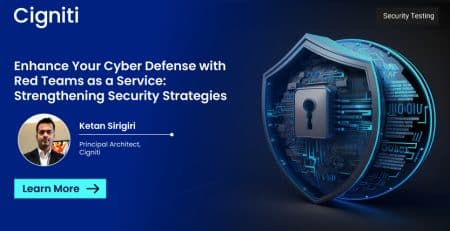Top 6 Fundamentals Of Cloud-Based Application Security Testing
Millennials with new technology interfaces are shifting the entertainment zones from television to mobile-based or device-based applications. Preferences are changing, which is impacting the overall application development cycle. There is no scope for any downtime or hiccups in customer experience. For instance, how long would you prefer to stick to an application if it keeps getting hung and doesn’t offer you the expected smooth experience? Likewise, Application Security Testing is a growing concern, as most applications carry highly sensitive financial or personal data. Hence, enterprises are considering Cloud-based Application Security Testing to validate the results and ensure quality.
Why is Application Security Testing critical?
The need to ensure that the application is secure and the data it holds doesn’t get leaked is getting much more critical. As per the statistics from 2016 and 2017, cybersecurity threats are on the rise, dwindling enterprises’ confidence in venturing into the consumer market. Application security activities bring in software, hardware, and procedures to safeguard applications from potential digital threats.
Application Security Testing has gained much significance in recent years. Traditionally, it was an aspect that could get missed in the software design, but today, there is no scope for that. Today, applications are more accessible over networks, which makes them vulnerable to cyber threats. A robust application security strategy and mechanism are needed to minimize the possibility of attacks and make the application much more resilient.
The key objective is to stop malware from accessing, stealing, or manipulating sensitive data.
In the current scenario, there is a probability that all the active enterprise applications are hosted on the Cloud. This poses another set of challenges in Security Testing of enterprise applications – From ensuring accessibility to exploring its scalability across various features. Fundamentals of cloud-based application security testing induce a different perspective. It explores the feasibility of hosting the security testing tools on the Cloud for testing the applications on the Cloud.
It is not a new process but a relatively fresh one for conducting application security testing. With this process, the applications are tested by hosting the solutions or tools on the Cloud. This contradicts the traditional application security testing pattern, which requires on-premise tools and infrastructure. Enterprises moved to cloud-based testing patterns to make the process more scalable, faster, and cost-effective.
Likewise, the focus is shifting from ensuring the applications’ security to accelerating the testing process. Cloud-based application security testing has been considered to solve many such queries and make security testing much more flawless and hassle-free. While we say so, we are trying to estimate the key essentials that your Cloud-based security testing strategy must consider.
Key factors to consider for Cloud-based Application Security Testing strategy
Cloud-based testing has its own set of challenges. To name a few, building distributed computing capabilities, standardizing processes, ensuring the security of the applications, and many more challenges related to the accessibility of the Cloud at any point. Hence, any Cloud-based testing activity needs to have set fundamentals.
These fundamentals must be especially considered while selecting and implementing a solution/tool for Cloud-based Security Testing. These basics will help you develop your strategy further and make it more result-oriented.
Look at Speed
What could be the main reason for any strategy change? One of the key objectives would be to bring speed and accelerate the testing process. Cloud-based application testing must help scan the software faster for potential errors and reduce the turnaround time. Your solution should have the capabilities to run parallel scans even from distributed locations.
This would apply more in an Agile and DevOps set-up, where teams could be co-located. This will bring speed to the testing activity and efficiency, resulting in faster development and testing cycles.
Need Scalability
Your testing activity should bring scalability to the testing process. This clearly implies that the solution you implement must be scalable and expand as organizations grow and need better configurations and updates. If scalability becomes an issue, it can impede the testing activity and create issues regarding speed, accuracy, and efficiency.
Ensure Accessibility
In an Agile set-up, global teams are co-located, and all the teams work around the clock to deliver on the application. Hence, the solution/tool must be available online across the browser at any time. It must also provide a centralized dashboard that offers features for collaborating seamlessly in the security testing process.
Bring Cost-effectiveness
All global businesses need cost-efficiency to keep launching fresh customer propositions. This aspect of ensuring cost-effectiveness goes down to every level of application development. Any tool/solution applied for security testing must bring higher RoI and reduce testing costs.
Rapid scanning of the devices and parallel execution of tests will bring down the testing efforts and costs. Ultimately, no number of iterations must incur higher costs with the tool.
Monitor Quality outcome
We have decided to mention this towards the end, as this is the ultimate achievement point for any team. The solution or tool must provide precise quality metrics for constant monitoring. This has to translate into performing accurate scans, contextual reporting, resolving issues, tracking the code and test cases, and many more parameters.
Minimizing risks
Application Security Testing has to result in minimizing risks and building robust software eventually. The parameters related to risks must be defined to ensure that nothing is missed. Even when the tool/solution is selected you must ensure that all the listed risk areas are covered in the security testing strategy. This can be a foolproof way to ensure quality and track the threats your application can foresee.
Application security is a broad topic, and a lot can be explored and experimented with to ultimately bring down the risks. The cloud-based model can be successful and applicable if the process is well-strategized. Logically, it begins by defining the testing parameters and taking the next steps accordingly. What’s your take on factors to consider while working on the fundamentals of cloud-based application security testing strategy? Do share your views in the comments or write to us.
Connect with Cigniti experts for any Application Testing or Security Testing strategy or solutions.





Leave a Reply